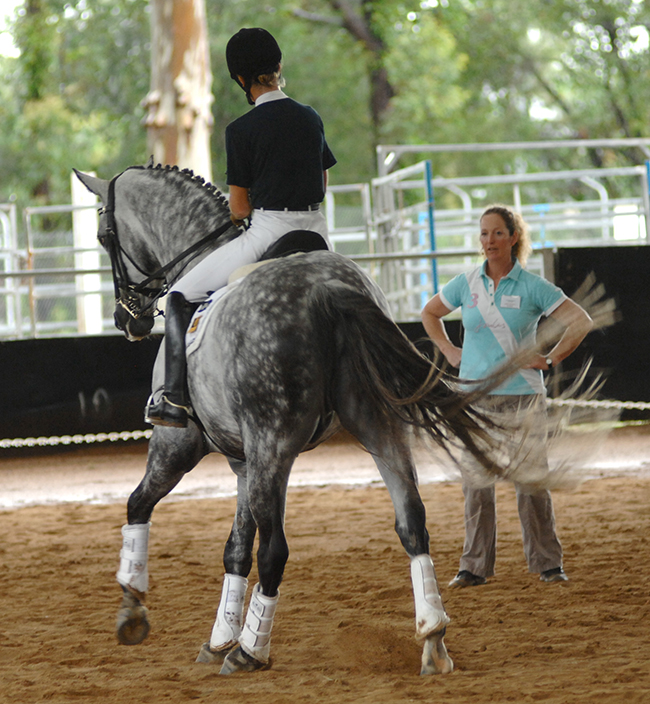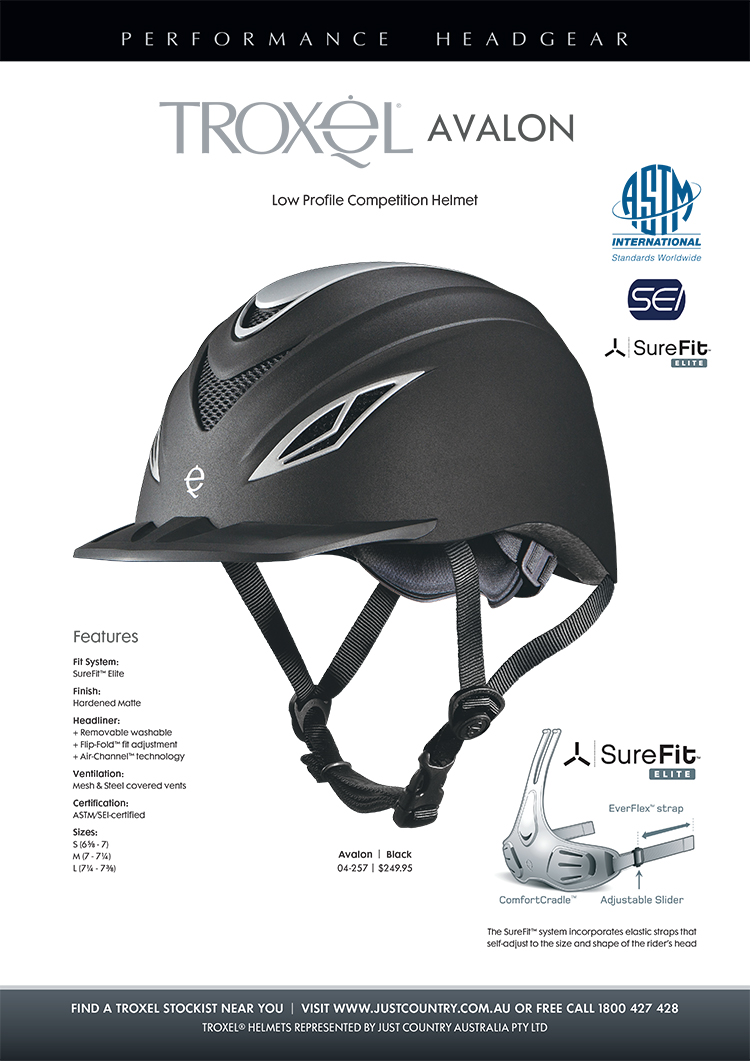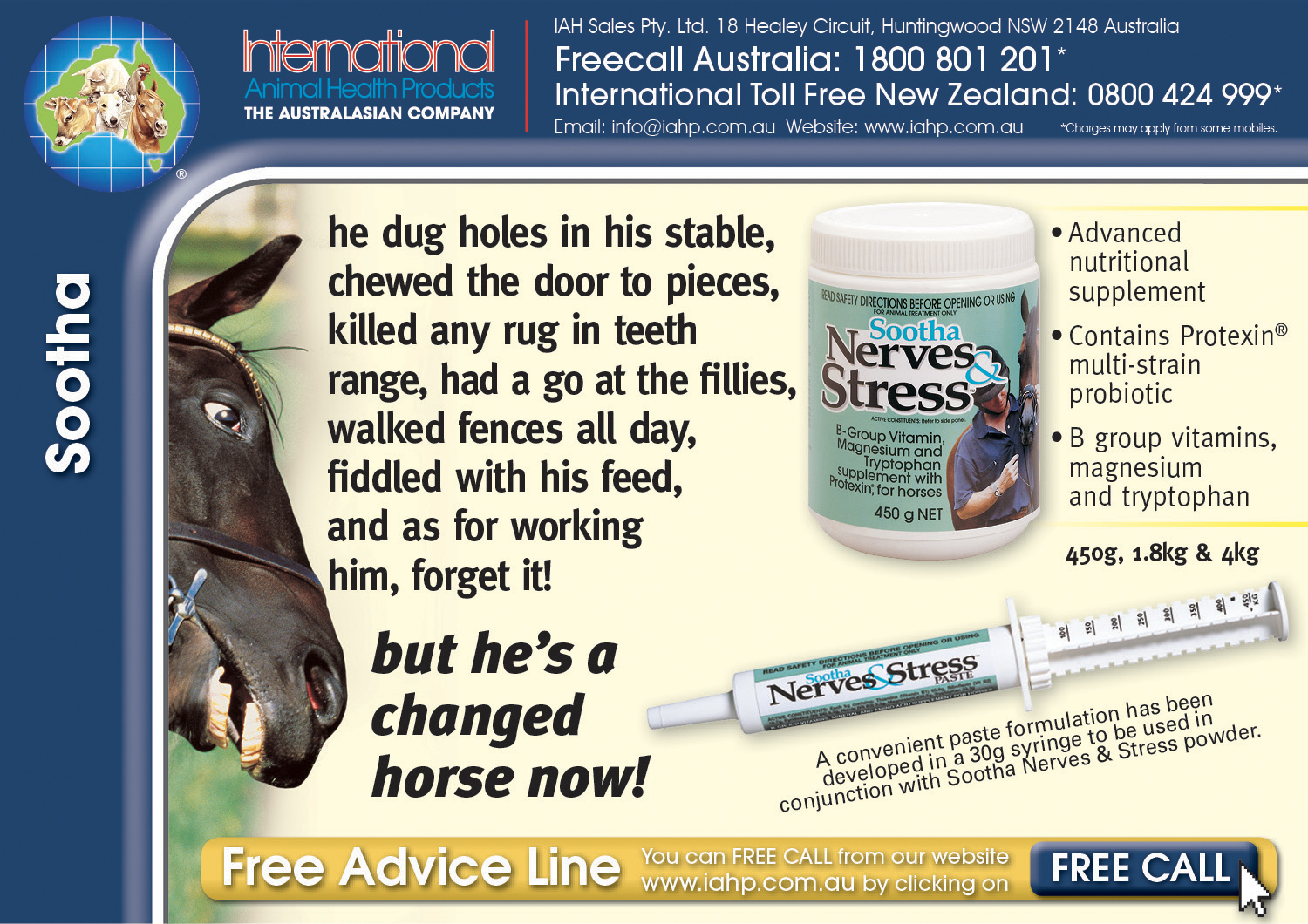It’s very odd. Australia currently doesn’t have a dressage coach, and yet there are a number of very talented, experienced trainers, who have competed successfully themselves and produced successful students, that EA continues to ignore and who end up teaching those who are prepared to go to the expense and work of organising the clinics. Why not subsidise our top riders to go to these clinicians?
Like Leonie Bramall who has been coming to Australian since 2010…?????
Shannan Makauskas meets Leonie Bramall at the Queensland Dressage Forum and chats to her students
Photos by Alex Makauskas
Leonie Bramall has a foundation of training in the German system, and a genuine love of horses and interest in the way they learn, Leonie produces the elements of the training scale in a positive way, and one that is successful in competition.
At the Queensland Dressage Forum more than 110 spectators, including over half of Queensland’s judges, huddled together in the indoor arena at Caboolture show grounds. Competing against the din of torrential rain, Leonie instructed several riders to execute test movements and demonstrate her approach to training.
Queensland Judge Convenor, Lesley Sullivan, said: “We decided we wanted to have an expert from overseas and we were looking at getting Leonie last year. Then Mary Seefried spoke to Jenny Gehrke who said, ‘Well I’m getting Leonie out so why don’t I coincide it for when the forum is on?’”
The atmosphere in the arena made it quite a task keeping the more hot-headed horses’ concentration. Two water tanks next to the arena were overflowing in what could have been seen as a man-made waterfall, but was instead received by the horses as a certain death threat.
Many bookings were cancelled on the day due to people either being flooded in, or concerned they would be flooded out, if they left their properties. For those who battled the weather it proved to be well-worth the trip, with Leonie’s methods producing pleasing results despite the distracting atmosphere.
Leonie addresses the judges before beginning the demonstration: “We have a rule in Germany which I think is the best thing, and that is that you have to be allowed to get the horse in the ring and settled before they ring the bell.”
“What is the harm in letting the horse and rider have a trot around? They’re all getting the same advantage. It just doesn’t make sense to me. We need to use common sense and give the horses the benefit of the doubt.”
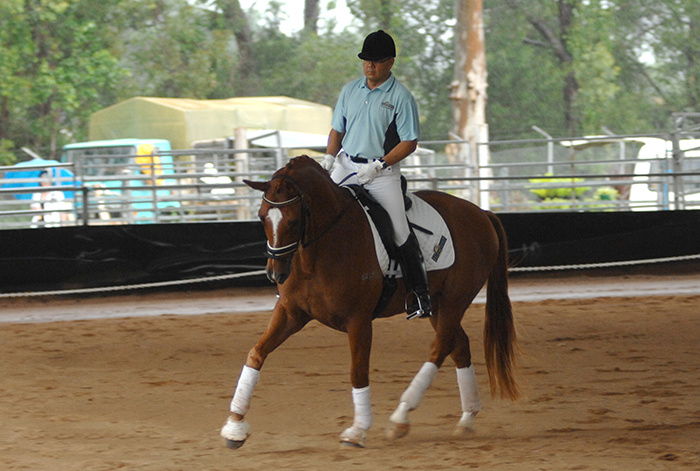
First in, Gary and Chester
Gary Lung was first in, riding the scopey six-year-old gelding GB Winchester (Weltmeyer). The combination rode in their first clinic with Leonie a year ago: “I’ve often watched Jenny (Gehrke) ride, and I’ve watched Jayden (Brown) ride, and to me they were on the right track. I thought something’s happening here and then Jenny told me about Leonie and I went, that’s the secret. I want to have a look.”
“From day one, I think what to me was so spot on with her, is she explains things in such a way that was like, it wasn’t black or white, it was colourful. She just had this information and she will personally tell you there is something wrong, or you need to fix it, but this is how you fix it. Not like you’re crap, or you’re no good, but here is a weakness and this is how we fix it, we do this and we do this.”
Leonie makes several points while Winchester happily cruises around the arena in complete harmony with Gary: “Its not about strength or pressure, it’s about training your horse to be more sensitive and to react.”
“Don’t give your reins away in order to go forward, they need to learn to push up through the withers. Concentrate on riding from the back end forwards, and keep that circulation of energy going.”
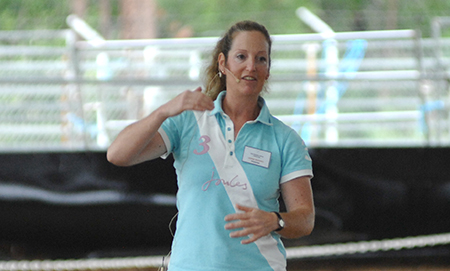
“Keep the circulation of energy going”
Leonie aims to train the horse to be a happy athlete: “As soon as we turn a horse into a robot and it loses that sparkle in its eye, it’s dead, and doing that’s not something that interests me. We don’t want to see a horse just going through the motions.”
“If you hit them or press horses that haven’t been taught to respond they’re going to push back harder. Teach the horse not by pulling, teach them to follow signals. You touch them, tickle them and they want to follow.”
next we ask Gary what he got out of the clinic
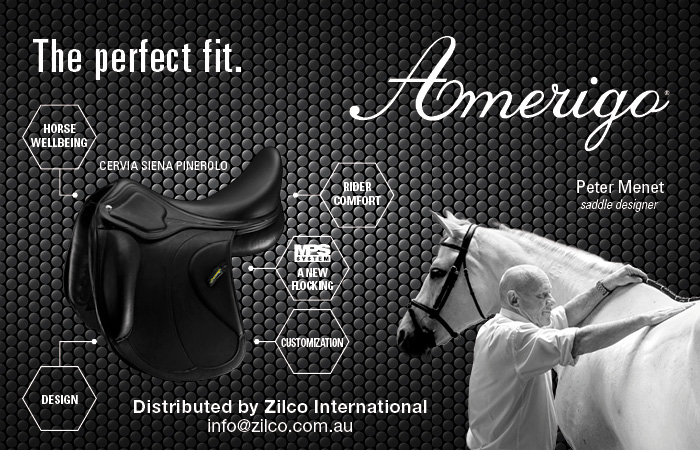
Interviewing those who participated in the clinic prior to the Dressage forum was inspiring. Their renewed optimism and excitement about the training system was infectious and Gary Lung was bursting with ideas:
“For one she just made Chester so much straighter because I had issues with straightness with him. I had issues with him starting to sit and collect. He would do all that big flashy young horse stuff, but now we’ve stepped up a level and the pressure’s put on and that’s where she came in.”
“I love the way her whole idea is just getting the horse in front of your aids and up in the wither, she calls it the third dimension. You still ride them round but you must ride them up. I always thought you just do it in the transitions, just do plenty of transitions and the back will come up. But I didn’t realise in my downward transitions I was actually pushing the horse’s back away.”
Gary explains how he came to this realisation: “She has these Pilates bands that she uses to make you feel some different things and develop an awareness of what you’re doing with your body. It’s like a big rubber band and she’ll wrap it around different places to teach you to stretch down, it’s all about stretching into and in front of the aids.”
“It’s now a little bit like Edward Gal where they look like they’re sitting on a toilet. It’s all about the chair seat which we all use to laugh about. When she puts these bands on, you ride around trying to focus on stretching down because if you don’t the band retracts and you go ‘dong’.”
“What it does is show you is what was in the wrong position to start off, with and as soon as you take them off what happens is your legs go longer and you feel like you’re getting sucked into the saddle, it’s fantastic. So in my transitions on one hand I was lifting the back up and on the other I was pushing it away with my seat.”
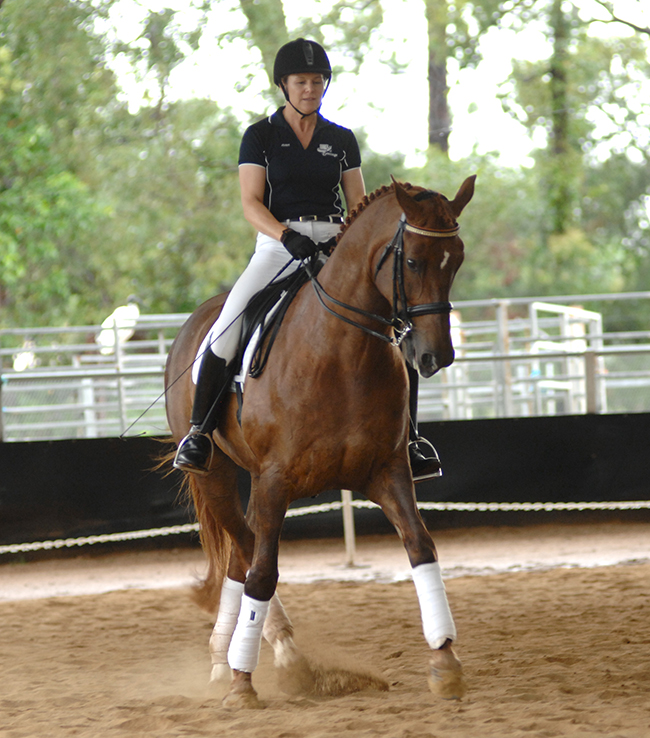
Organiser, Jenny, and Gitane
Jenny shared similar advice: “In the moment of a half halt she said to, ‘Allow the back up through your pelvis, the way you’re using your stomach is great but you’re sending it through to your pelvis as well and pushing the back away. Just let it go.’”
Gary confirms: “With her it’s constantly ride it up and she’s got no tricks. It’s just like transitions, riding them up and connection.”
The riders point out Leonie’s ability to think outside the square when communicating what she wants. Jayden Brown said: “How many trainers will tell you that a good half halt is like having a pillow come up through the horse’s back and carry you along?”
“Leonie will think of a thousand ways to tell you something until she finds what makes you click. She doesn’t just stick with the typical phrases like, more active or more hind leg. Sometimes it’s just mixing up the way the message is presented that really helps the learning process.”
Gary shared some insightful expressions from his lessons: “With your transitions she says, ‘Go up and down like a switch. It should be like turn a light on, turn a light off. Not hold a button and switch it on slowly. It’s just switch it on, switch it off.”
next Nicole Tough and Dante
It’s back to the forum with Nicole Tough riding the eye catching dapple-grey gelding Dante (De Niro) owned by Beau and Linda Dowsett. Leonie instructs Nicole to ride a 10 metre circle: “It’s important we don’t come into it and have everything fly to the outside and derail.”
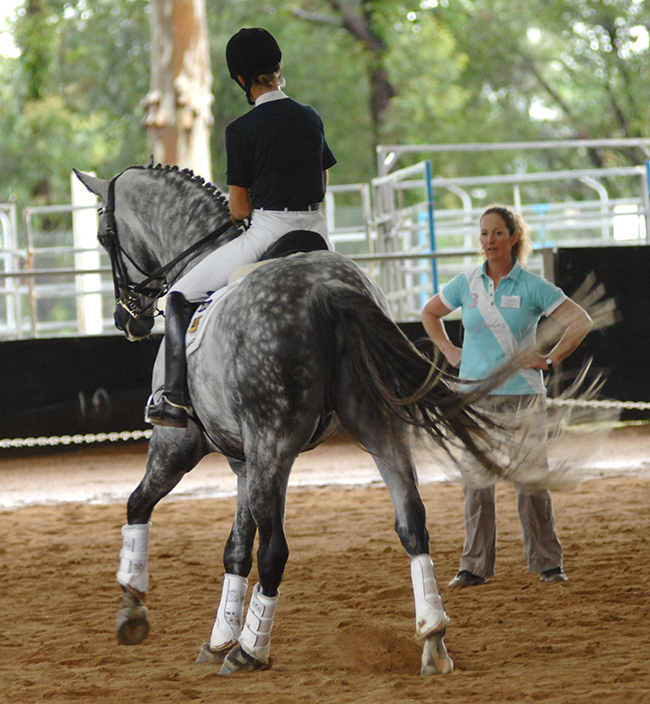
Nicole and the elegant De Niro son, Dante
“Don’t give your reins away in order to go forward. They need to push up through the withers. It’s riding from the back end forwards and keeping that circulation going.”
Nicole also participated in the clinic prior to the forum with Leonie, and after the first time working with her, was teeming with new ideas: “One was in the half halts because I’ve always thought of a half halt as being half of a halt. I know it’s a reconnection of energy, but I was thinking about it more from the bottom of the hind foot up over the back and into the bridle, in a circle that way (counter-clockwise).”
“I didn’t realise in my halt halts that I was shutting him down, that it was a backward connection of energy. I always had this picture of riding the horse in a circle of energy, but Leonie changed the direction of that circle.”
“Another massive thing for me was I’m always trying to get them lighter in the contact. I’m always trying to get them off the contact so they’re not strong and she was saying, ‘No, no, no you’ve got to push them onto the contact.’ Which was a really different concept for me and it means you have to ride with a lot more energy.”
On the subject of contact, Leonie said: “People want a horse on a soft contact, but the contact is your communication. You have to have a positive pulling. The horse getting softer in the contact should be indicative of the activity from the hind legs and loading behind. Don’t throw away what you’ve created.”
“The frame of a horse is always indicative of the engagement from behind. Every horse is different, and you can’t force them all into the same frame. Everyone is always worried about where their heads are. Are they over the vertical? But what’s more important is are they in front of the leg?”
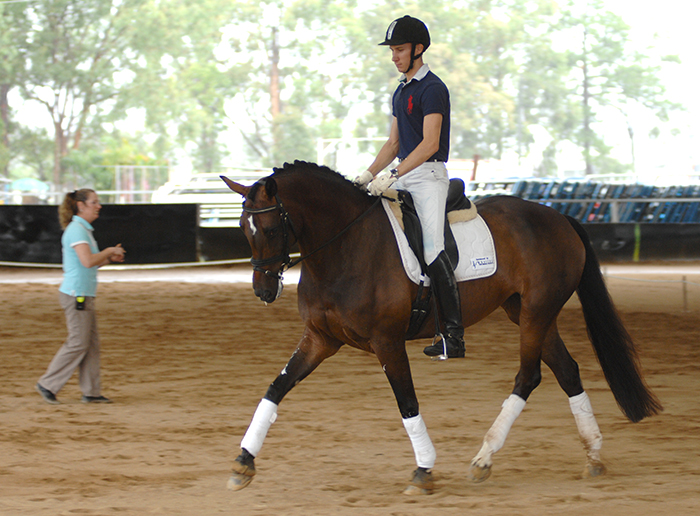
Jayden and the Hanoverian mare, Dallas
Prancing into the arena next is Jayden Brown on the imported Hanoverian, Dallas (Dacaprio/Cashman), owned by Kate and Perry Wilson. The six-year-old mare is bursting with energy and Jayden tactfully directs that into the lateral work. Leonie said:
“We need this reactive energy later, but we need to teach her to cope with it. The rules are yes she’s allowed to look, but no, she’s not to run to the inside or away from the leg.”
Leonie gives tips on riding sensitive horses in a competition atmosphere: “I would do some half halts in a shoulder-in to keep her supple without losing that static. I try to use a little flexion and shoulder-in and get the horse to follow my leg. If Jayden just holds her there with his contact we’re going to miss something down the track.”
“We want to enhance the difficult things, not hammer them. Using our skill we need to aid them to be better athletes. If they’re tense, how are they going to bend their joints? An elastic horse is a healthy horse. It’s actually not teaching them to put in more effort, it’s about teaching them to release and be more elastic so they have a bigger range of motion.”
next Jayden rides F¨ürst Friederich
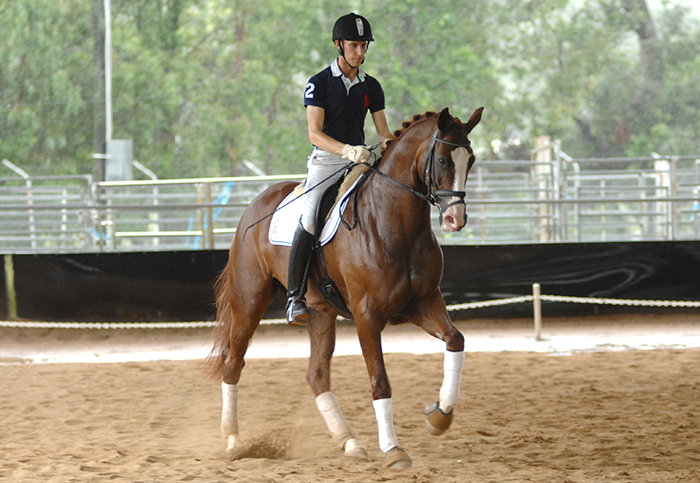
Jayden and his ‘F’ line ride, Fürst Friedrich
After some wonderfully expressive laterals Jayden moves onto his next star this season, Fürst Friedrich (Fürst Piccolo/Anooschka), who he found at Leonie’s barn last year. Leonie draws on the talented combination to demonstrate the medium work: “Flying changes do not get better by doing millions of changes. We need to go back to increasing the quality of the jump and collection in the canter.”
Leonie works on collecting the canter: “Ride with the quarters in down the long side. Now do some transitions on the circle, now a working pirouette. You don’t teach them to collect by sitting them down and blocking them. You’re extending and collecting. Closing the horse, but keeping the joint’s mobility.”
Leonie points out some common mistakes: “People get so stuck on getting the change that they forget about the rest of it. That’s not the point of the exercise, you have to keep the quality of the pace. The horse should be up in front of you in the wither and you’re getting sucked into the seat. There’s a big difference between being up from the underside of the neck and being up over the wither.”
“Enhance the rhythm with half halts before the change. You have to do your homework and set yourself up for success. Because whatever you program into them, you have to re-program if there’s mistakes. Rather than just trying to get a change, work on fixing the basics.”
Jayden shared the process of teaching flying changes with Dallas: “Leonie got us to approach it quite differently to the work we did with Fürst Friedrich because she is a lot less established at that level.”
“We have to manipulate her body much more to allow her to change correctly. We use a lot of counter canter on the 20metre circle and then add travers to the mix. So she is essentially bending in the opposite direction to her canter lead.”
“Once she is reliably straight through her body then the changes just happen. But if I allow her to lean into my leg or become crooked through her shoulders, it doesn’t work.”
Perfecting the half halt was also a feature of his lessons with Leonie: “We did a lot of work to make sure that when I ask for a half halt, the horses don’t compromise their frame and the activity of their legs. Quite often the horse thinks the half halt is just slowing down, or even just stopping. But to get them to keep the activity and also maintain the same softness through their body is a little more difficult.”
Leonie reflects on this at the forum: “Jo Hinnemann always used to say, ‘If you’re losing the quality of the paces in the movement you’re doing something wrong.’ The horse should change positively with work. They need to keep working from behind without shutting them from the front of the withers, they must stay open and engaged from the hindquarters.”
This brought the forum to a close and rather than feeling weighed down by so many concepts, I left feeling positive and ready to approach riding in a more tactful way. Leonie has been a breath of fresh air on the Queensland dressage scene and I can only hope the clinics will be opened up so the rest of us may benefit from her teaching.
Getting to know Leonie…
Growing up in the horsy neighborhood of Southlands in Vancouver, Canada Leonie was able to indulge in several disciplines: “I went to pony club and had to do western, jumping and the whole works, which gave me a really good base because you get a good feel for a horse.”
Dressage eventually became her concentration and she enjoyed numerous victories as a young rider, including being a member of the gold medal winning team at the North American Young Riders’ Championships in 1981 and at just 15.
At 18 Leonie became restless with the dressage scene in Canada: “I grew up there and I had the same issues and problems that you guys are having. So I was living off clinicians.”
“Jo Hinnemann was the coach for Canada when I was a young rider and he came for a clinic and I went, ‘Wow this is it, this is for me.’ I felt like I was on the right track and I’d been to a lot of clinicians and tried lots of stuff.”
In 1984 she made a life changing decision to train in Germany at Hinnemann’s barn. Leonie summarises her trip: “I planned to stay for two years, then bought my mare and went to the Olympics. I just had to slog it out. I was a working student and I didn’t have the ability to pay for it. So it was a long haul and I sometimes think, ‘Wow, you know, she managed.’”
The combination debuted in their first season of Grand Prix, not only in a foreign country but also with the likes of Reiner Klimke in the class. They went on to become a member of the Canadian team at the 1992 Barcelona and 1996 Atlanta Olympics, as well as the World Championships in 1994.
It’s an extraordinary feat and certainly rare for an 18-year-old to buy a three-year-old horse and, eight years later, take that same horse to the Olympics in dressage: “I think back now and I’m like oh I was so lucky because usually they go lame or something goes wrong, but I think I made it happen because it was my only shot, and there certainly wasn’t going to be a second chance there.”
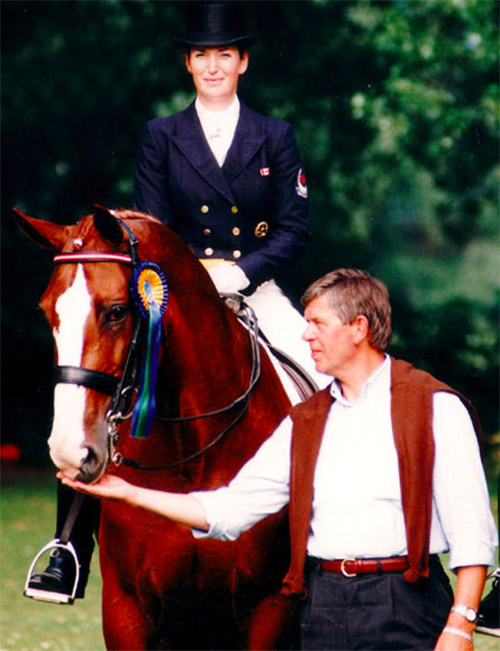
Leonie, Jo and Gilbona
Leonie remembers the exceptional Oldenburg mare, Gilbona, and their time together: “I mean she was very difficult, she was very full on, very hypersensitive and non-functional as a young horse. So it was a journey with that horse and she taught me so much. I wish I had her now because I think I could have really done her more justice.”
“She was amazing how she helped me because a lot of it was self learning. I didn’t have someone standing there ever day giving me a lesson. I had to really get my head around concepts and things and ask why isn’t it working? How can I change my riding? What am I doing?”
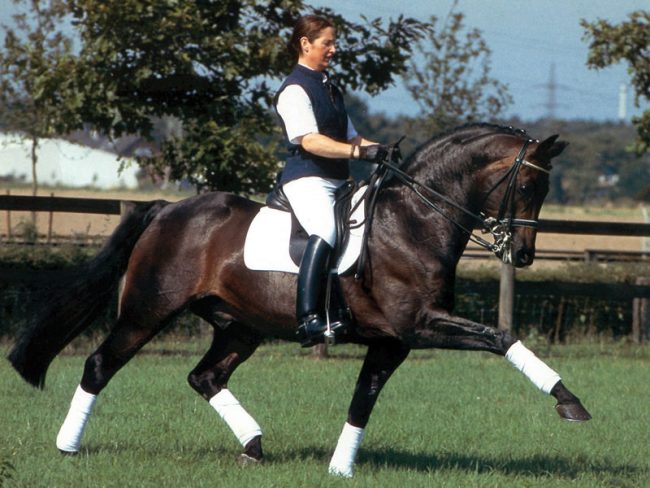
Leonie and the stallion Rohdiamant from the famous Vorwerk stud
During this time Leonie was also given the opportunity to train several notable horses including Rohdiamant, Relevant and Inspekteur, as well as Fosbury who she rode to win the 1992 German National Championships for young horses.
Leonie has now been living in Germany for over 30 years and operates a training facility and breeding station with her partner Volker Dusche in Gestüt Mühlenort located centrally, close to Hamburg, Hannover and Bremen.
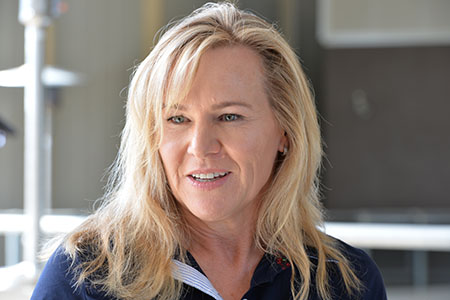
Since 2006, Australian Development Squad rider Jenny Gehrke has trained regularly at Leonie’s barn. But in 2008 she sat down with another one of Queensland’s competitive riders, Kate Wilson, to discuss how they could bring the German training experience to them:
“We had a conference and said, ‘Well if it costs us $10,000 to go to Germany for two weeks aren’t we better to spend that $10,000 and get Leonie here for two weeks?’”
“We try not to think about it as a per lesson cost. Not because it’s too disturbing, but because it’s not about the cost of a coach per hour, it’s about having days with her and immersing yourself in her system which is really on the German training scale.”
“Then it’s the work-shopping with each other and the discussion of our lessons and if you just say the whole experience cost me a couple of thousand dollars, it’s money well spent. You wouldn’t get that kind of experience on a short trip to Germany because you’re not on your own horses.”
Since introducing the clinics to Australia, instead of going to Germany for a refresher, Jenny has been concentrating on what she calls ‘dressage nut camp’: “Leonie comes into Australia for three or four days, flies out to New Zealand for ten days, then comes back to Australia for three or four days.”
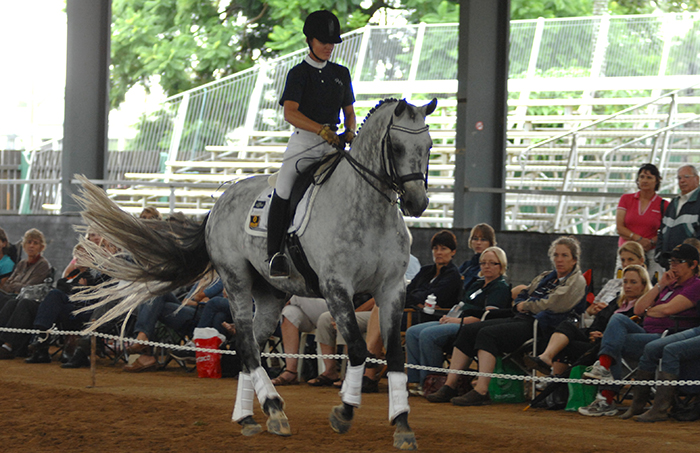
“We get two clinics each time she comes, so we get to go and flounder a little bit, and then she comes back and says yes or no, and tells you if you’re on the right way. She comes twice a year so we actually get four clinics.”
Rather than opening the clinic up to all Queensland riders, the group focuses on a few people who have a few horses each. Jenny said: “Quite a few of us are coaches as well so we’re able to pass on what we’ve learnt to our students.”
Results at the Australian Dressage Championships over the last three years show a vast improvement in Queensland riders. When I look closer at Leonie’s Australian based students I find these are the same names featuring in the championship titles; Jenny Gehrke, Jayden Brown, Nicole Tough, Victoria Welch and Gary Lung. So could Leonie be their secret weapon?
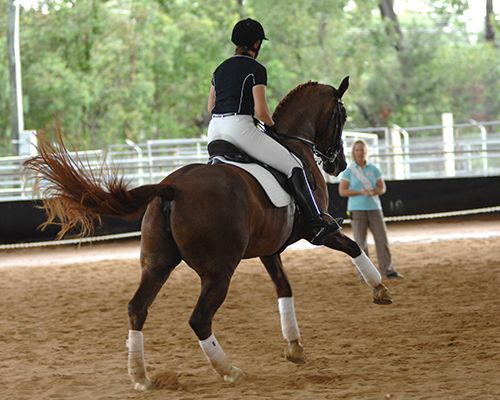
Gary Lung said: “I certainly think she’s adding to Queensland dressage. I mean we had the likes of people like Tor Van Den Berge coming in to set the standard and we’ve gone, ‘We’re going to have to lift our game.’ So the standard in Queensland is just getting higher and higher.”
“I think us as riders, we’re starting to look at resources like Leonie with skills and experience to help us develop, and all of us who’ve had lessons with her who are coaches, will pass on what we’ve learnt.”
Jenny is impressed with Leonie’s love of teaching: “She’s very passionate about communicating a message across to you, it’s amazing. We’ve had Leonie teach 12 lessons, and then come inside and we’ll hand her a glass of wine, and I’ll be sitting down in another section of the house watching a video of my lessons from the day.”
“She’ll come and join me and she’ll end up sitting there for three hours watching people’s lessons with them and talking about it. She’s not like other guys who come from overseas and they’re like, I have another life I don’t want to talk about horses, she does. She likes talking about horses, and she likes doing other things as well, but you know she’s really, really passionate about it, and I find that so refreshing for someone who’s done the slogs in Germany.”
“You know, 12 hour days, seven days a week for 20 years. She’s done the slogging and she’s still passionate about it and I think she really enjoys that about us, that we’re riding for the right reasons.”
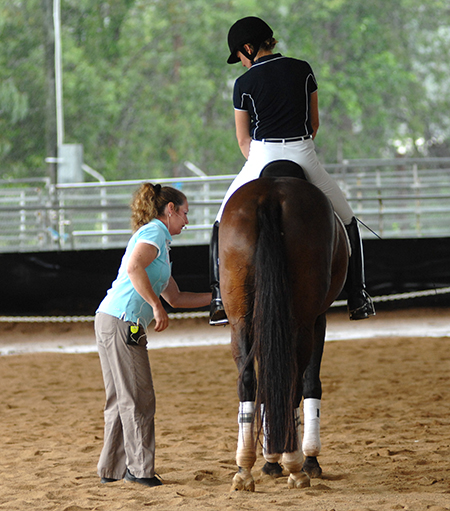
I sat down with Leonie to get her view on the Australian dressage scene:
Have the riders improved since your first visit in 2008?
“Definitely. Now there’s really an understanding of the concept of training with their horses from some sort of a base. They’ve established a strong basis of communication and connection with their horses. They’re also understanding what a half halt is now, understanding when the horse is in front of the leg, the frame, you know the whole base scale and that’s just moved them on up.”
“There’re a lot of advanced riders here, but they were riding in a bit of a hole and they’ve not been able to move on and improve their scores and improve their horses so it’s been about making that happen and that’s happening now.”
Has it mostly been about improving the basics?
“Well people try to push up the levels too quickly. They’re trying to get to advanced, just for the sake of getting to advanced, without understanding the depth of the basics. You have to know about keeping a rhythm, and know what proper collected trot is.”
“You can’t get collection without riding from the base into the contact, and that base is what makes the rest of it all build up like a pyramid, but you have to have the foundation. If the foundation is bad, the building falls down. If the horse has a lot of talent, it can compensate up to a certain level, but if a horse learns a flying change it’s not just about doing a flying change.”
“It’s about doing one for a 9, and you only do that by enhancing the canter, getting the horse more through gymnastically, making his muscles react better. It’s like with any athlete, they all know how to do their sport, but they only get better by doing cross training. It’s also about understanding their biomechanics and their physical limits, then working on expanding them.”
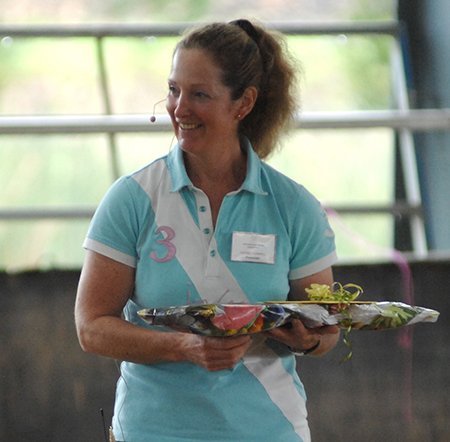
How does this compare to the work you do with your German students?
“It’s the same problems in Germany. There’s just a lot more riders there. It depends how you want to address the problems as a rider, and what your personal interest is. I have a lot of riders who come to me because they take a personal interest in delving into it more, and having the horse so they don’t just have to push harder or kick harder, they want to have the horses reacting off signals.”
“They come to me because it’s a different way of teaching, it’s more of an understanding of the horse. I think more about how I’m communicating with the horse, and it’s usually not a horse problem, it’s usually a rider problem. So if I can make a rider aware of what they’re actually wanting to happen, then they can understand why these things aren’t happening, and then they can start to change things.”
“I think in Australia there’s actually a lot more riders who take care of working on physio and those sorts of things. Where as in Germany it’s like, ‘well get on with it’, so both have advantages and disadvantages. If you can get someone who works on those sorts of details, and get them to help you, that can also help. There are some extremely talented riders over here.”
How important do you think it is for riders to train in Germany?
“It depends on where you end up. Just going to train in Germany is not what it’s all about. There’re a lot of bad trainers in Germany, just as there are a lot of bad riders in Germany. Then we have a lot of good trainers and good riders as well. Some people just want to go and have someone say, ‘Yep cool, do this-and-that and you’re riding’. But it’s everybody’s own personal journey.”
“For example if you do it like Jayden, he came to us for a year and we really immersed him into the system. It was just getting him riding and really understanding the concepts over that year, and explaining why we start what we’re doing with a four-year-old, how that’s going to help him when he is three years, four years down the road, trying to teach him to do a canter pirouette.”
“You know, you have a journey, you have to plan it in your head for the long term. That’s just my system. But you can just go over to Germany and ride a bunch of school horses and ride around thinking you’re important, but the riding involves so much more.”
“It’s really upstairs, it’s in your head. It’s really where you’re at, and where you’re centered, and then taking a deep breath. It’s taking the emotion out of your riding and finding the center of your balance so you’re really having that horse go forward with you.”
What drives you to succeed in such a challenging sport?
“It’s a passion and I can’t help myself. I have such a passion for trying to have people understand their horses better. I ride because I love horses. It’s not just a job for me. I’m very passionate and when I see the way everyone rode today it makes me so proud of what they’ve done.”
“To show these people there’s no spur marks on these horses, they’re not pulling on their mouths, they’re concentrated, you can see the horse is clicking in this difficult situation and that’s what it should be like. We’re trying to make things happen.”
“Everyone has a calling I guess and this is mine, to connect horses with their riders. The horse is always trying to tell you something, and I just say, well that’s the way it is. You work through it and maybe it’s just that way, it’s like people, they’re not all perfect, and you’re trying to train an animal and make it perfectly square, left and right, and most people are completely one sided, so then they’re doing their horse an injustice.”
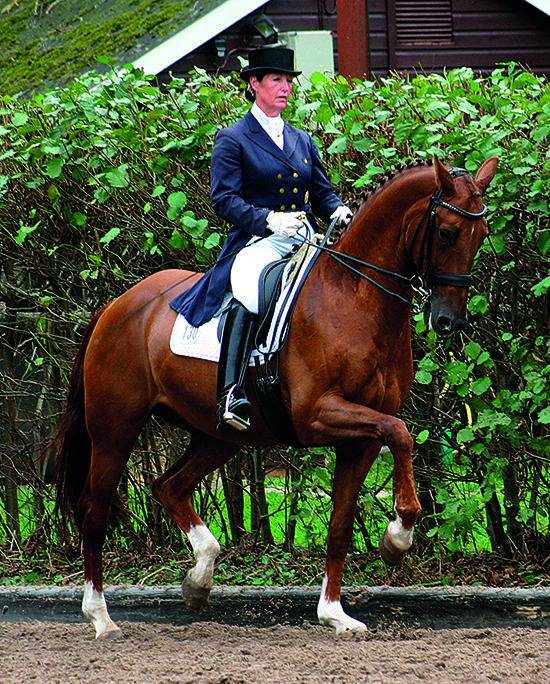
Leonie and Orion in passage
“So it’s just making them aware of what they’re doing, and it doesn’t mean that they shouldn’t be riding, it’s just, you know, awareness is what triggers your brain and puts you into the thought process. Then they can think about their own style, and how they’re reacting, and think about what’s happening. I think it just makes the world more of a comfortable place for people and their horses.”
“Of course you have to challenge them, and sometimes they get a smack or whatever, but it’s putting it into the realm, and not punishing a horse who doesn’t understand. That’s very important, you don’t need to punish them, you correct them. But doing it in a certain way, with the intensity necessary, and then immediately after the correction, you let it go.”
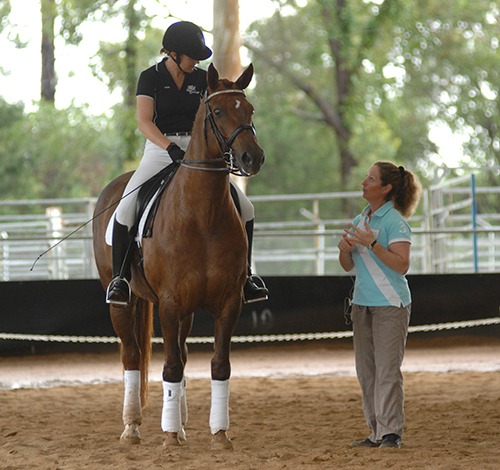
What do you still want to achieve in dressage?
“As much as I can. I just enjoy moving the young horses along, it’s very rewarding. Perhaps in the future, when my own personal riding career goes down the tubes, which happens to all of us, going on to be a National coach for my country.”
“At the moment I’m still not willing to take that commitment because I enjoy riding so much myself. But helping people who want to maybe look at their training from a different angle, not just doing what everybody else does and making the technical picture happen.”
“That’s what I find very interesting and very rewarding. It’s just been amazing working with this group of riders here, because it’s people who are not doing anything wrong, but it’s just trying to develop them and take them round the corner once and say, ‘Look over here’.”
“They’re all good riders but let’s just look over here, maybe there’s something that she’s missing. Take that aspect into it, add an aspect and then get them creating their own stuff. It’s not me actually telling them, ‘You’re doing it wrong, do it this way’. It’s just me throwing something at them and saying, ‘Why don’t you try that?’ And they’re like, ‘Oh’, and I go away and they play with it.”
“They need that time to flounder, and if they can feel things and make things happen themselves it makes them better riders.”
“The cool thing is that some of those people are coaches and are putting that into their own students. That for me is a very rich compliment because that’s your own system and they’re opening on themselves and moving on, that’s a huge compliment for me.”
What did you learn from your time with Johann Hinnemann?
“That it doesn’t happen overnight it takes years. I was very fortunate because a lot of times people go to Germany for a year or half a year and think, ‘Okay I’ve gone to Germany I’ve done all that.’”
“I’ve been able to take a lot of horses from very green or very young up to the advanced levels and they all have difficulties, but it’s actually teaching them to be functional good competitors and getting them out in the ring up to advanced.”
“Unfortunately once we start connecting them into Grand Prix, usually they get sold. That’s just what happens it’s my job. I don’t have an independent sponsor, so I don’t have any of those options.”
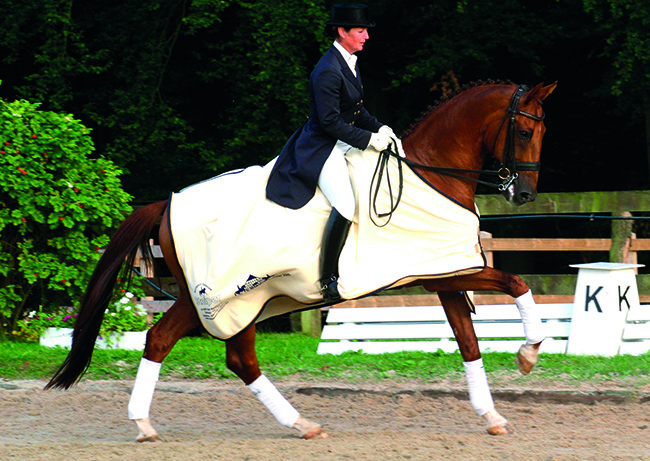
Leonie and Orion
How often do you get lessons?
“I work with Heike Kemmer a lot. I will go over to her place once a week and help her out by being her eyes on the ground, and if I have a horse, I’m getting prepared for a test I’ll drive over and she’ll help me.”
“I don’t have a regular coach in that sense so I sort of have to coach myself. I have a mirror which I use a lot but I’ve always, even at Hinnemann’s, I had to help myself a lot.”
“But certainly your feeling sometimes does get off a little bit on the wrong track so you do need someone every now and then to have a look. Working with Heike, she works at an extremely high level, so it just keeps you tuned in and aware and gives you a little bit of a reminder.
What was it like coaching Heike at Beijing?
“That was an amazing experience. But it’s not like you’re coaching, it’s just about being their eyes on the ground and if the riders are getting to the point, I mean they’re not nervous they’re good competitors, it’s just that if you’re thinking the horse is nagging you at one little spot you have to say, ‘You know what, it’s irrelevant. Just leave it alone.’ It’s all good because you know each other well enough to say that. But it was an amazing experience. Dealing with the weather and the whole situation was cool, it was fun.”

